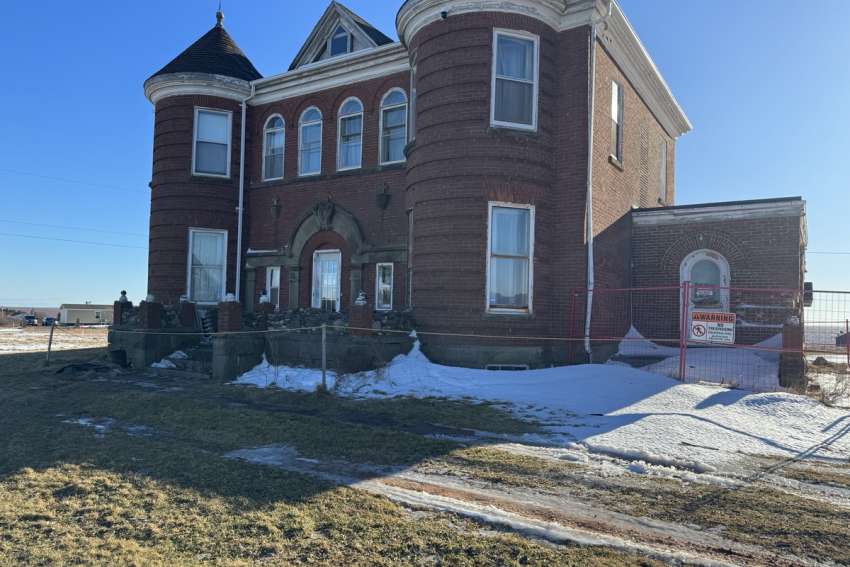Though Eker wrote this in Secrets of the Millionaire Mind: Mastering the Inner Game of Wealth, somehow it perfectly encapsulates the unfolding story of Dean MacArthur, a stonemason based in Prince Edward Island.
Last spring, MacArthur, owner of DinoMac Masonry, was commissioned by the Sister Antoinette Des Roches Historical Committee to restore four monuments at Notre-Dame-du-Mont-Carmel Church in the village of Mont Carmel, P.E.I. The monuments included three stone archways that lead to the church, built in 1898 by local Acadian artisans, and its cemetery. One of the archways is also a cenotaph that honours the local soldiers who perished during the two World Wars. The fourth monument is a stone mausoleum dedicated to Fr. Pierre-Paul Arsenault, the Acadian pastor who spearheaded the construction of the 126-year-old church.
For MacArthur, who is following the footsteps of his father and grandfather with his chosen profession, repairing the archway directly in front of the church required the most work.
“It was in the worst condition as it had begun to split apart,” said MacArthur. “Over the years, essentially the inside of the mortar had eroded and washed away, leaving big cavities inside of the monuments. We had to seal them with a lime mortar so they can last another 100 years or more.”
This spring, MacArthur will put finishing touches to the monuments so they will be ready for a special celebration the historical committee is planning. There is a lot to commemorate. Not only did two of the arches turn 100 in 2023, but this restorative enterprise was also a triumph of crowdfunding, with $20,000 raised for repairs and more than $5,000 to outfit each monument with a digital plaque containing historical information. MacArthur’s work has been appreciated by locals and visitors to Mont Carmel. However, it is his efforts to resurrect the neighbouring rectory, established in 1903, that is truly capturing people’s imagination.
“We were talking about it, and they asked if I was interested in taking it down,” said MacArthur. “I thought they meant taking some bricks off to save for the church. They informed me that they were talking about demolishing the building because it had become unsafe inside, and it had been empty and vacant for over 20 years.”
Remarkably, even though he had no historical or personal tie to its past, MacArthur — who came to Canada from England over seven years ago — felt, without hesitation, a conviction to save this heritage building.
“Right then and there I said, ‘No, this cannot happen.’ I offered to buy it right then and there so we could save the building.”
Initially, MacArthur’s motivation stemmed from his innate nature as a stonemason “with a heart brimming with passion for heritage preservation.” But as word of his project gained notoriety, he drew inspiration and energy from a legion of well-wishers.
“I have not only received hundreds of messages from around the world from people thanking me for taking on this project to save the rectory, but I have also had people in the community — most of them in their final years — tell me stories about how they used to go to the rectory for breakfast after choir practice, have confession upstairs and eat there in the rectory when there was no food. There was always food in the rectory.
“When they found out I was going to restore it, the looks and smiles on their faces… you could see they were reliving those happy memories. I really want to see some of those people walk through that building again when it is restored.”
MacArthur’s commitment to rehabilitate this parish house to its original splendour is absolute, but does not mean the enormity of the task has never given him pause. Walking into the long abandoned structure for the first time provided quite a shock.
“It was very overwhelming,” said MacArthur. “It took me about a week to digest it and wrap my head around what needed to be done there. But once it kind of settled, and I had walked through the building a few more times and looked at things more closely, it started to make sense that, ‘yes, I can repair it.’
“A lot of it had to come out with all the floors being collapsed. Once we started to remove those floors we really saw the vision of it coming back together.”
MacArthur and his crew had to shore up the basement to support the collapsed floors, and the whole house was so moldy he had to run a dehumidifier for three months, which would remove over 45 gallons of water per day. This process made the mold treatable.
In perhaps a stroke of divine providence, MacArthur took interest in this project at just the right time. He said if “the house had been left like that for another year, nothing would be salvageable.”
MacArthur is providing updates via Instagram and TikTok. His Instagram handle (theparishproject) alone is followed by over 435,000 people, and growing. He has posted videos and photos detailing the work and showcasing treasures he has discovered, including a cherished framed picture of Fr. Arsenault and a visitor book containing the signatures of Queen Elizabeth II and Prince Philip, who visited the rectory in 1973. They also found the tea set gifted by the late British monarch.
Originally, the plan was to complete this restoration over four years to keep costs down, but the massive social media attention it has attracted has opened the doors to a potential television or streaming deal, with HGTV, Netflix, Discovery Channel and CBC having expressed interest.
“If this goes ahead, it will accelerate the process as it will allow for more funding,” said MacArthur. “We would be able to probably move this up to between a year and 18 months.”

